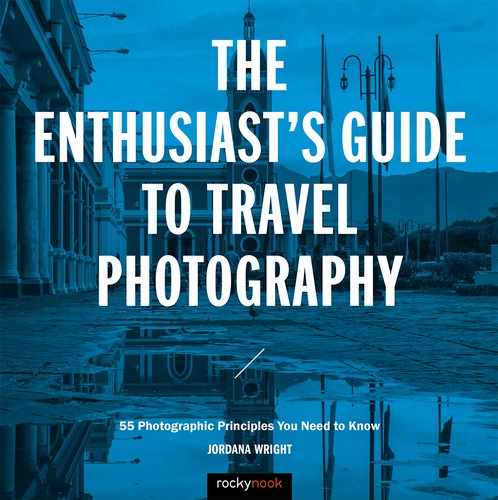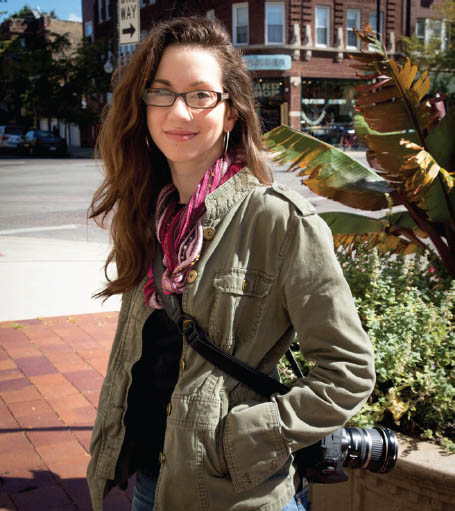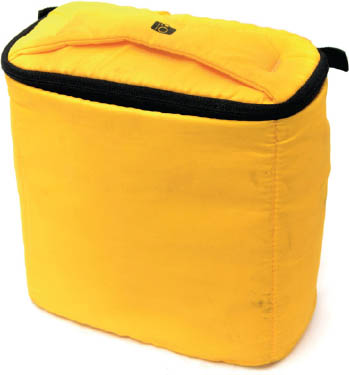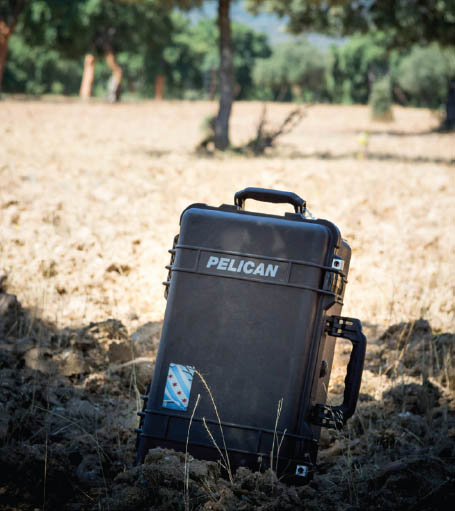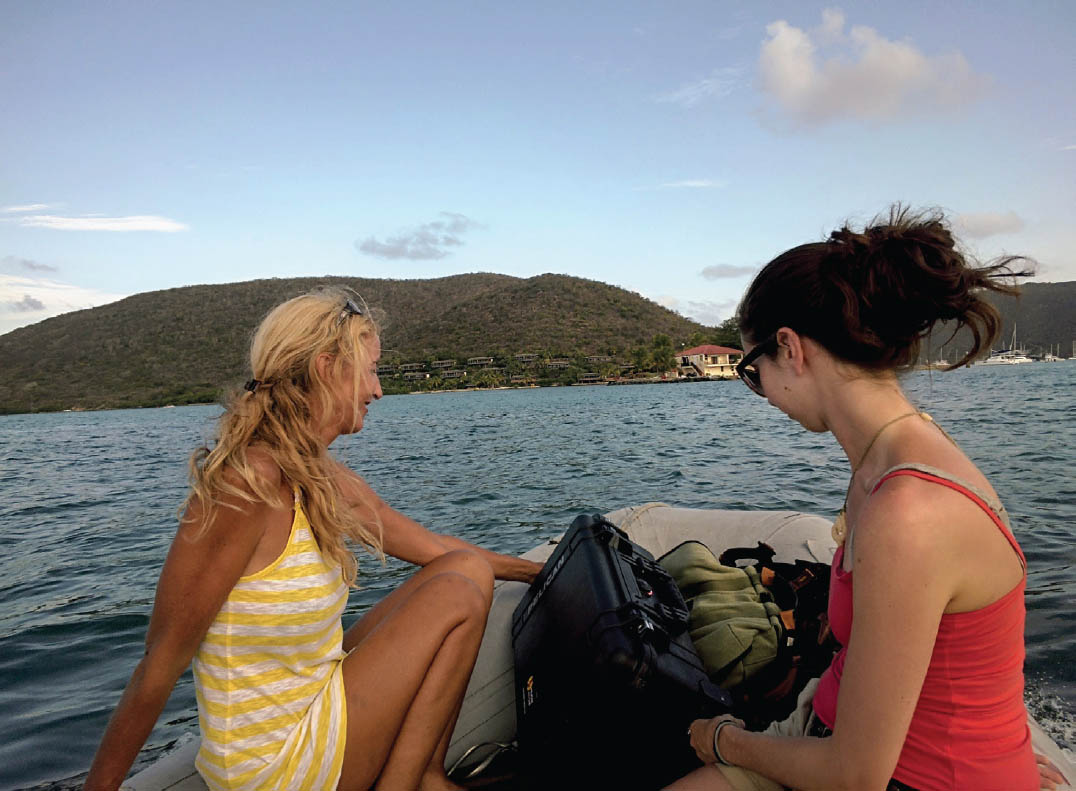20. STRAPS, CAMERA BAGS, AND CASES
![]()
I LEARNED QUICKLY that when I hit the road, I need to be comfortable and organized to create my best work. You can find a ton of carrying and storage products on the market, so many photographers go through a few camera bags and straps in the process of finding the one that best suits their needs—I certainly did! Don’t let all your hard work and planning go to waste with a setup that’s unsustainable for long days of shooting. With some strategic gear selection, you’ll be prepared for any adventure and free to focus on shooting.
Straps
You buy a brand-new, super amazing, super expensive camera. You open the box and fill with excitement as you pull each accessory out of the box and remove it from its little plastic packaging. It’s all so new, so clean, and so thoughtfully designed—all except for the factory camera strap, which is the photographic equivalent of using a piece of rope as a belt. Sure, it “works” for my grandfather, but it’s ugly and uncomfortable and strangers may point and laugh.
Factory camera straps draw undue attention to you while you travel—they literally spell out the make and model of your camera—making you an obvious target for theft. Because the factory straps are so short, they’re only wearable around the neck (uncomfortable) or on one shoulder (unsecure). Eventually camera companies will catch on and provide a better default product, but in the meantime you have so many third-party options to choose from.
Crossbody or sling straps are industry favorites. They provide security and beneficial weight distribution, and most have been designed with lots of features for increased functionality. Companies like JOBY and BlackRapid have even taken the contours of the female body into account and offer crossbody straps designed for women (Figure 20.1). Very often they have expandable sections of strap that allow you to bring the camera from your side to eye level without tugging the whole camera strap around you.
Frequently, crossbody or sling straps attach to the camera’s tripod mount rather than the strap keepers on the sides of your camera, which can complicate matters when using a tripod. Fortunately, there are many adapters and plates on the market that will allow you to connect a screw-mount plate and a screw-mount strap at the same time.
If you like to keep your camera handy and ready to go, then a hand or wrist strap might seem like a no-brainer. They’re a great option for lighter-weight cameras, but for full-size DSLRs a hand or wrist strap can cause some definite fatigue over the course of the day. I like to stay mobile and prefer to keep my hands free when I travel, but I love that my camera feels better supported in my hand while I shoot with a hand strap. For me, the happy medium is to keep a hand strap on my camera as well as the crossbody strap. The hand strap is there when I want it, but it’s not my only camera gripping option. I just tell myself that it’s not weird to have two straps on one camera.
For serious shooters and wannabe gunslingers, the next level of camera-strappery comes in the form of camera harnesses and holsters. As more photographers work and travel with multiple cameras, strap manufacturers have come up with some great ergonomic ways to comfortably shoot with two cameras. Many photographers love the weight displacement of two-camera shoulder harnesses, but if you’re hiking with a backpack on, you have limited real estate in the shoulder and side regions. Camera belts are a great way to take some weight off your shoulders while carrying your camera and keeping your hands free, though you should use extra caution in crowded situations.
Whatever type of strap you end up using, pay attention to the materials used and read user reviews. Focus on ergonomics, breathability, padding, and functionality over flashiness or price and you’ll be a happy traveler.
Camera Bags
Just as factory camera straps can make you a target for thieves, camera bags and backpacks that blatantly look like camera bags and backpacks are asking for trouble. There are so many brilliantly designed camera bags with fantastic padding, room for laptops, and homes for all your tiny, delicate accessories, but at the end of the day, if they have an identifiable photography gear manufacturer logo on them, they draw way too much attention for travel.
As I mentioned in lesson 13, “What Do You Really Need?”, I love modular camera pouches or inserts that can be used with any non-photography backpack. I have the flexibility of using different-sized backpacks for different trips or situations, I have more choices in style and design, and non-photography bags are generally much less expensive. My go-to camera inserts (Figure 20.2) were sadly discontinued by the manufacturer, but there are tons of similar top-access padded inserts on the market in a variety of sizes and styles.
If you prefer to use bags or backpacks specifically designed for photography, then you still have an overwhelming range of options. Whether you prefer the ergonomics and distribution of a backpack or the easy access and flexibility of a messenger or shoulder bag, there are a few things to keep in mind when looking for the best choice for travel photography:
- Bags made of waterproof (or at least water-resistant) fabric offer a sense of gear security that is worth the cost.
- Access zippers on the back side or in an unexpected location will help keep your gear better protected.
- A mesh or foam back panel will be your friend on long or hot days.
- You can never have too many cinch straps. I use cinch straps to carry my tripod, extra water bottles, muddy boots, even additional bags.
- Mobility is key, so look for a bag with a slim profile that can still accommodate necessary non-photographic items like keys, wallet, snacks, or a tablet. Bonus points for a water bottle pocket.
- Cover any blatant photography company logos with black gaff tape (quick and dirty) or decorative patches (pieces of flair) for theft deterrence.
Cases
Before I owned a Pelican case, I fantasized about Pelican cases. I imagined rugged off-road adventures with an incredibly sturdy, hardcore Pelican case by my side (Figure 20.3). I pictured motoring from ship to shore in a dinghy with a delightfully waterproof and buoyant Pelican case at the ready (Figure 20.4). In my mind, ownership of a Pelican would lead to a more exotic photographic life. The cases are that amazing.
20.1 Look at that happy, relaxed, and comfortable photographer with her ladies’ JOBY strap.
20.2 Camera inserts make any bag work as a camera bag.
20.3 Look at that sexy, rugged Pelican in the Spanish cork forests.
For getting to your destination with maximum security and gear protection, there is no better option than a Pelican case, but for active shooting on a hike or the street or at a museum, they are wholly impractical. There are harnesses that allow you to wear a Pelican like a backpack, but you’ll still need to stop, take it off, lay it down, and open it up to access your gear.
If you choose to go the Pelican or hard case route on big travel days, get the wheeled carry-on size 1510 or 1535 and employ a modular camera insert system like I do. You’ll get the best of both worlds—waterproofed security and ease of mobility.
20.4 Even if the dinghy sinks, the Pelican will float and keep my gear safe.
